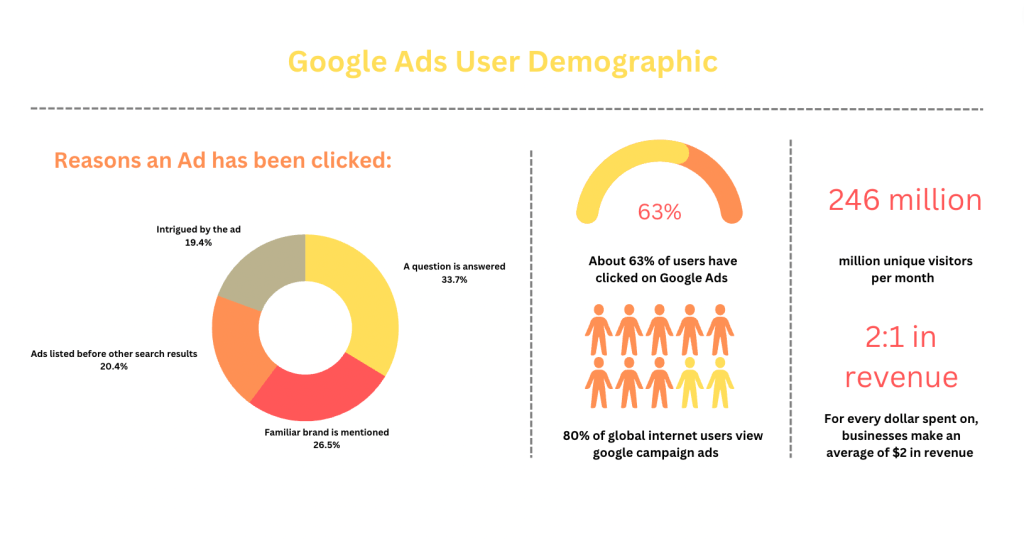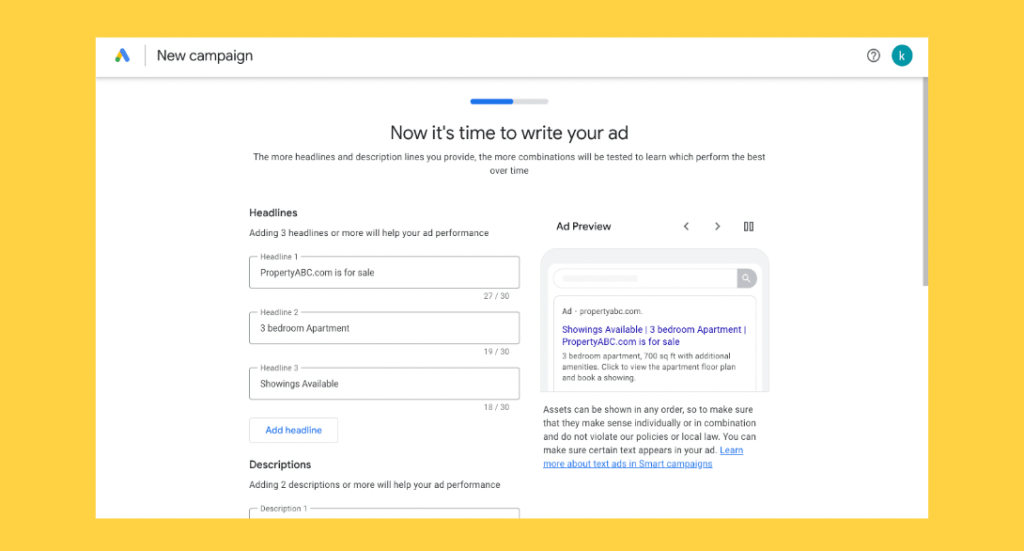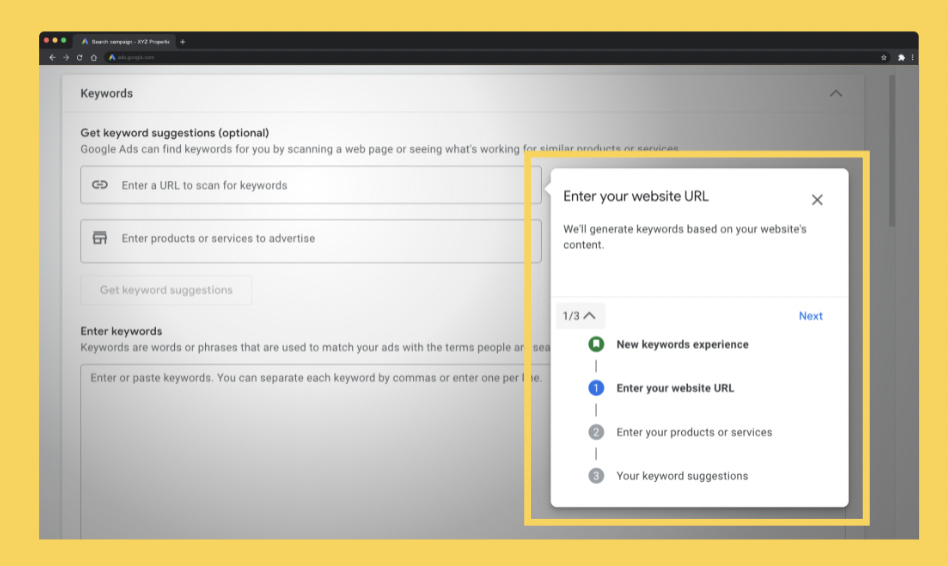Successful digital marketing in the rental property business involves knowing how to use online marketing tools to your advantage. One of the most powerful of these tools is Google Ads. It allows advertisers to create targeted ads that appear when users search for specific terms or phrases, known as keywords.
This guide will provide clear, step-by-step instructions on how to start advertising your rental properties using Google Ads. Additionally, ways to maintain your ads, track their success, and the importance of latent semantic indexing (LSI) keywords for effective ad performance will be covered.
Brief Overview of Google Ads
Advertising rental properties on Google has several key advantages over other advertising platforms:

Understanding the needs of general users and reasons for selecting a posted ad can optimize rental property advertising strategies. For example, recognizing that ads are often clicked when the brand is familiar and the search query is directly answered, you can determine whether your advertising goals should focus on establishing your brand or online presence and familiarity, or meeting user needs.
Understanding the Google Ads Pricing Model
Google uses a Pay-Per-Click (PPC) model – you’re only charged when someone interacts with your ad. This, coupled with the ability to set a daily budget, ensures you get a high return on investment.
Your ad placement is determined by Google’s Ad auction – Adwords Intelligence. Once you create your ad for your rental properties, you proceed by placing bids on keywords. The higher the bid placed, the more likely your ad will be closer to the top of the search page. Adwords intelligence will determine where your ad will be placed based on the cost per click you have set and the quality of the ad.
Additionally, set budgets can be made to ensure that the increase in website visitations does not cost you a fortune. After creating your account, visit “Campaigns” and find the campaign created for your rental properties. Select “Budget” and enter your daily budget (Tip: If you have set a monthly budget instead, divide the set monthly value by 30.4.)
Starting your Google Ads Account
Step 1: Create your Google Ads Account
Visit the Google Ads homepage and click ‘Start now’. You’ll be prompted to sign in with your Google account. If you don’t have one, it’s free to create. Once signed in, follow the prompts to set up your Google Ads account.

After that, you’ll be prompted for additional information regarding the website you’d like users to visit upon clicking your advertisement for your rental property.

Step 2: Set Your Goals
Select “Create” and choose “Campaign” to get started. You will then be given the choice to identify your objective and fill out additional information that relates to your goals. If you’re uncertain what objectives will benefit your rental properties, it is covered below.

After identifying your goals, you will be asked to write your advertisement. When it comes to writing your advertisement to create the campaign for your rental property, there are certain things to keep in mind to maximize the effectiveness of those ads.

Step 3: Create a campaign
Setting Your Rental Property Goals
Positioning your ads to attract tenants requires a deep understanding of their needs. Establishing clear goals for your campaign can help determine the type of campaign you should launch whether your goal is increased website traffic, more inquiries on your rentals, or reduced vacancy rates.
To start, you can utilize Google Ads in two primary ways: Search Network and Display Network.
| Search Network: appeal to looking customers | Display Network: increases visibility |
|---|---|
| Shows ads to users actively searching for rental properties | Places rental property ads on several websites that potential renters might be browsing |
Additionally, here are the types of campaigns to consider launching based on your rental property campaign goals:
| Campaign Type | Objectives | Rental Property | |
|---|---|---|---|
| Search Campaigns | Text ads on Google Search | – Boost sales/ leads /website traffic – Easy setup – Specific targeting | Optimal for reaching people with higher purchasing intent |
| Display Campaigns | Image ads on various websites | – Drives sales/lead -Brand Awareness – Extended reach & re-targeting | To stay top of mind with potential renters and retarget visitors to the rental property website |
| Smart Campaigns | Automated campaigns using Google AI | – Drives sales/leads – Easy setup – Advanced optimization | An efficient way to advertise rental properties with minimal setup and effort |
| Performance Max Campaigns | Multi-channel AI-optimized campaigns | – Easy setup -Increased conversions -Finds new customers | Great for expanding reach across various channels, finding new renters, and optimizing marketing efficiency |
| Video Campaigns | Video ads on YouTube and other websites | – Brand awareness – Drives sales/ leads – Extended reach, re-targeting | To give potential renters on YouTube a visual tour of the property, reaching a wide audience and retargeting interested parties |
| Local Campaigns | Promotes physical locations across channels | – Drives in-person store sales – Promotes offers/events -Provides location info – Multi-channel marketing | To bring potential renters to physical rental locations or offices |
| App Campaigns | Promotes your app across channels | -Promotes app -Multi-channel marketing -Easy setup and management | Useful for property owners with an app to streamline booking and inquiries |
Once you’ve decided on the type of campaign to launch for your rental properties and have completed setting up your account, you can proceed to the next step – creating your ad.
Creating your Ad & Leveraging LSI
Having identified your goal, understood their pricing model, and set up your account with Google Ads, you are ready to start your ad creation process.
Leveraging LSI keywords involves using alternative words and phrases that are semantically related to your primary keyword. Things like synonyms, closely related words, or phrases that often occur in the same context as your main keyword are optimal for the best outreach.
To start, choose keywords that users looking for rental properties would input to find their future homes. For instance, words like, “apartment for rent”, “home for rent”, and “2-bedroom apartment” are common searches users may choose when looking for rentals. Alternatively, instead of creating keywords from scratch, you can input your website’s URL link and Google can recommend keywords.


Additionally, you can leverage campaign settings to ensure your rental properties are reaching a relevant demographic by viewing the Campaign Settings to view your options.
Campaign Settings
Start by choosing locations to target your advertisements. This can be narrowed down to one or multiple postal codes, neighborhoods, cities, or countries.

** The assets created can be tailored to suit your preferences – you can create lead forms for potential tenants to view and indicate their interest, and create several headlines, images, logos, and videos which Google will then mix and match to track the most successful combination. **
Launching Your Campaign
Bidding
Once the keywords have been selected, the next step in the bidding process is launching your campaign.
After choosing objectives, you’re taken to the bidding portion of the process where you can decide how you want to track your ad success – these are some options to keep in mind that can help substantially grow interest in your properties and lower vacancy rates:
| Method | Pricing Method | Benefits |
|---|---|---|
| Conversions | Target cost per action | Only be charged when a specific action is completed (ie. a purchase, sign-up, or download) |
| Conversion Value | Target return on ad spend | Optimize your ad campaigns to focus on generating revenue rather than just conversions |
| Clicks | Maximum cost per click bid limit | Charged only when a user clicks on your ad. This approach is beneficial for driving traffic to your website. |
| Impression Share | Percent (%) impression share to target & Maximum CPC bid limit | Ensure that your ads appear a certain percentage of the time when relevant keywords or placements are triggered. This method helps you increase brand visibility and reach a broader audience while maintaining control over your maximum CPC bid. |
After you’ve input your daily budget or bid, your campaign will be launched. It will be ready for you to track your rental property ad performance!
Tracking Success & Making Necessary Adjustments
After creating your campaign, go to “Campaigns” and view the analytics tabs appearing:

Each portion of the tab will reveal more about your rental property performance:
| Tab | Purpose | Benefit |
|---|---|---|
| Overview | Gives you a brief insight into your assets – ie. your lead form or headlines created. | Refine your marketing strategies to better attract prospective tenants and fill vacancies quickly. |
| Insights | Shows interactions, cost, and interaction rate with your advertisement. | Analyze the cost-effectiveness of your campaigns & understand what drives engagement. If a particular ad is generating a lot of interactions but isn’t leading to conversions, you can adjust the ad to better meet your goals. |
| When and where ads showed | Indicates the time in which your ads were viewed, the location, and the device type used to interact with your ad. | If your ads are most often viewed on mobile devices, you can optimize your website and ads for mobile viewing. Understanding the most effective time to show your ads could also lead to better conversion rates. |
| Report Editor | Allows you to generate reports and edit report data to be downloaded and shared as needed. | You can create custom reports to track specific metrics related to business goals, like the number of new tenant inquiries or the conversion rate of property viewings to leases. |
Boosting Your Marketing Effectiveness
- Precision Targeting: With Google Ads, you can target your audience with laser-like precision. Utilize keywords, demographics, and interests to reach potential customers who are actively searching for your products or services – recall the user data provided at the start of the guide. With questions being answered or brand familiarity being the primary reasons that an advertisement is clicked on, it is important to leverage the keyword options you mention in your rental property ads to reach the most leads.
- Engagement through Ad Extensions: Google Ads allows you to enhance your ads with additional information such as site links, callouts, and structured snippets. These extensions provide more reasons for viewers to click, turning casual browsers into engaged prospects.
- Cost-Effective Campaigns: Google Ads offers a pay-per-click model, meaning you only pay when someone clicks on your ad. Experiment with different ad formats and bidding strategies to find what delivers the best ROI. It’s like having a customizable advertising budget that you can tailor to your business needs.
- Responsive Ads: Google’s responsive ads automatically adjust to fit different devices and screen sizes. This ensures that your message is always clear and compelling, whether viewed on a desktop, tablet, or mobile device. It’s like having a digital chameleon that adapts to its environment.
- Insightful Analytics: Utilize Google’s robust analytics to understand how your ads are performing. Monitor metrics like click-through rates, conversion rates, and cost-per-conversion to continuously optimize your campaigns.
- Building Brand Trust: Google Ads allows you to showcase your ratings and reviews right in your ads. By displaying positive feedback from satisfied customers, you’re not just promoting your products but also building trust with potential clients.
- Leverage Remarketing: With Google’s remarketing tools, you can target users who have previously interacted with your website or app. This keeps your brand top-of-mind and encourages them to complete their purchase. It’s like having a gentle reminder that nudges customers back to your business.
- Quality Score Optimization: Google Ads uses a Quality Score to determine how relevant and useful your ad is to the user. By optimizing for this score, you can achieve better ad placements and lower costs. It’s like having a guide to creating the most effective and efficient ads possible.
By leveraging these features and strategies, Google Ads can become a powerful tool in your marketing arsenal, helping you reach more customers, increase conversions, and grow your business.
In the fast-paced world of the rental property business, standing out in the crowded market is essential. Google Ads offers a dynamic and effective way to reach potential tenants and property buyers. By understanding the intricacies of Google Ads, from its pricing model to leveraging latent semantic indexing (LSI), you can create targeted and efficient advertising campaigns.
This guide has walked you through the essential steps to set up, launch, and track a successful Google Ads campaign for your rental properties. By following these instructions, you can not only increase your visibility but also optimize your advertising budget, ensuring that your ads reach the right audience at the right time.
Remember, the key to successful digital marketing is not just about using tools but understanding how to use them strategically. Continuous monitoring, learning, and adapting will keep your campaigns fresh and effective, helping you stay ahead in the competitive rental property market. Whether you are a seasoned marketer or just starting, Google Ads offers a scalable solution to help you advertise your rental properties.




